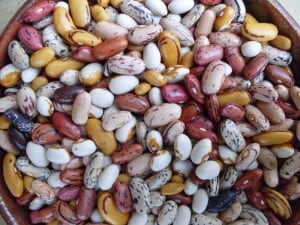Growing dry beans can be a fun & beautiful addition to the garden. If you have space, it is easy to produce homestead quantities of dry beans to feed your family. On a small farm scale growing dry beans can provide a profitable addition to the farmer’s market display. Conveniently, seed saving is the same as crop harvest for dry beans, which makes them a crop you only have to buy seed for once (unless you accidentally eat them all).
Here at Adaptive Seeds, we love to grow beans almost as much as we like to eat them (which is a lot). Producing them is a bit of a process but it’s pretty fun & you’re rewarded with piles of delicious, nutritious jewels at the end so it’s totally worth it.
As market growers, we were attracted to dry bean production because we saw a need for local staple food production – for food security as much as to fill a market niche – & soon discovered we could sell all of the beans we could produce. We also really like having dry beans fill a spot in our field rotations. In the past we have planted as many as 6 acres in dry beans, but it didn’t take us long to figure out that if we planted less acreage but took better care of it, we could have much higher yields & fewer headaches. Since we’ve shifted our focus to seed production, we have reduced our dry bean crop size further & now grow about ½ acre of beans per year, still selling some as food. Following is an assortment of tips & tricks for dry bean production, & details of our bean enterprise budget from 2014.
Planting
In our area (The Willamette Valley of Oregon), dry beans can be planted until the beginning of June, which means you still have some time to get a crop in the ground this season. Our goal is to sow our dry beans by mid-May, but we have successfully harvested earlier varieties (such as Early Warwick) from sowing as late as June 10.
